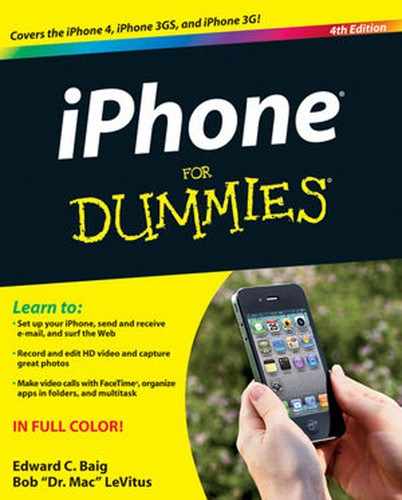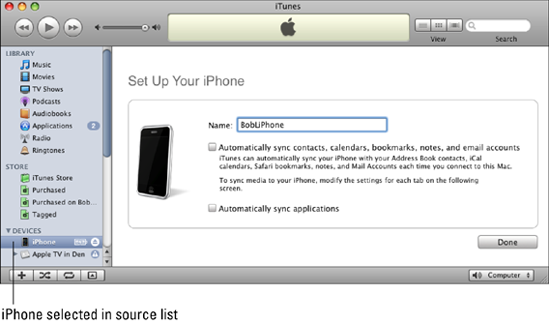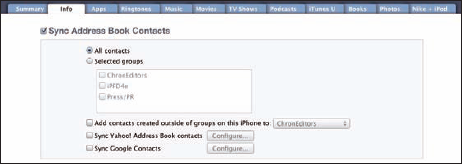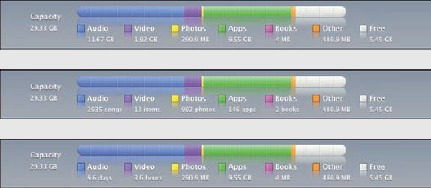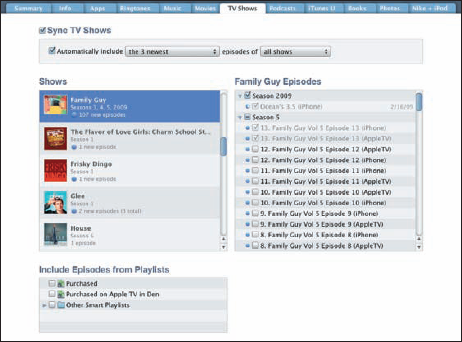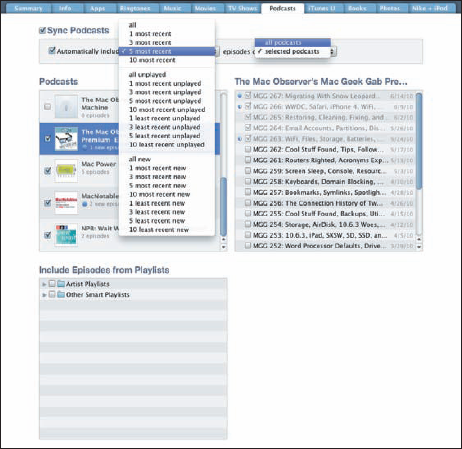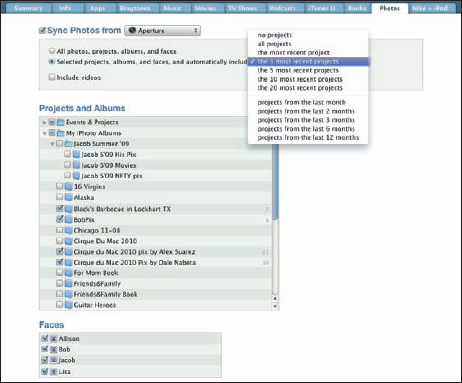Starting your first sync
Disconnecting during a sync
Synchronizing contacts, calendars, e-mail accounts, and bookmarks
Synchronizing ringtones, music, podcasts, video, photos, and applications
After you pass basic training (in Chapter 2), the next thing you're likely to want to do is get some or all of the following into your iPhone: contacts, appointments, events, mail settings, bookmarks, ringtones, music, movies, TV shows, podcasts, books, courseware, photos, documents, and applications.
We have good news and ... more good news. The good news is that you can easily copy any or all of those items from your computer to your iPhone. And the more good news is that after you do that, you can synchronize your contacts, appointments, and events so they're kept up-to-date automatically in both places—on your computer and on your iPhone—whenever you make a change in one place or the other. So when you add or change an appointment, an event, or a contact on your iPhone, that information automatically appears on your computer the next time your iPhone and computer communicate.
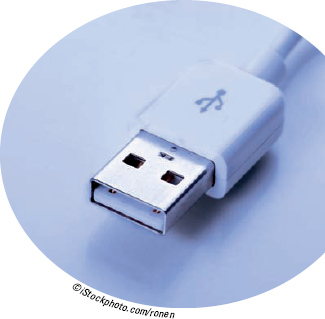
This communication between your iPhone and computer is called syncing (short for synchronizing). Don't worry: Syncing is easy, and we walk you through the entire process in this chapter.
Tip
The information in this chapter is based on iTunes version 9.2 and iOS (formerly iPhone OS) version 4.0, which were the latest and greatest when these words were written. If your screens don't look like ours, upgrade to iTunes 9.2 and iOS 4.0 (or higher). By the way, both upgrades are free and offer significant advantages over their predecessors.
Note
We regret to say that if, for some reason, you can't upgrade to iOS 4 or greater and iTunes 9.2 or greater, you should consider getting a newer phone or computer. Why? If you have an original, first-generation iPhone, you can't install iOS 4. If you're running a very old version of Mac OS X or Windows, you may not be able to install iTunes 9.2. And the new iPhone 4 won't run any version of iOS before version 4.
Synchronizing your iPhone with your computer is a lot like syncing an iPod with your computer. If you're an iPod user, the process will be a piece of cake. But syncing isn't difficult even for those who've never used an iPod or iTunes. Follow these steps:
Start by connecting your iPhone to your computer with the USB cable that came with your iPhone.
When you connect your iPhone to your computer, iTunes should launch automatically. If it doesn't, chances are you plugged the cable into a USB port on your keyboard, monitor, or hub. Try plugging it into one of the USB ports on your computer instead. Why? Because USB ports on your computer supply more power to a connected device than other USB ports or most hubs.
If iTunes still doesn't launch automatically, try launching it manually.
One last thing: If you've taken any photos with your iPhone since the last time you synced it, your photo management software (iPhoto, Image Capture, or Aperture on the Mac; Adobe Photoshop Elements on the PC) will launch and ask whether you want to import the photos from your phone. (You find out all about this in the "Photos" section, later in the chapter.)
Select your iPhone in the iTunes source list.
You see the Set Up Your iPhone pane, as shown in Figure 3-1. If you've already set up and named your iPhone, you can skip Steps 3 and 4a and start with Step 4b.
Name your iPhone.
We've named this one BobLiPhone.
a. Decide whether you want iTunes to automatically synchronize your iPhone and your contacts, calendars, bookmarks, notes, e-mail accounts, and applications.
If that's what you want, select the check box next to the option titled Automatically Sync Contacts, Calendars, Bookmarks, Notes, and Email Accounts to make a check mark appear, and select the check box next to the option titled Automatically Sync Applications. Then click the Done button and continue with the "Synchronizing Your Media" section, later in this chapter.
If you want to synchronize manually, make sure both check boxes are deselected (refer to Figure 3-1), and click Done. The "Synchronizing Your Data" section tells you all about how to configure your contacts, calendars, bookmarks, notes, e-mail accounts, and applications manually.
We've chosen to not click either check box so that we can show you how to manually set up each type of sync in the upcoming sections.
4b. Click the Summary tab near the top of the window, as shown in Figure 3-2.
If you don't see a Summary tab, make sure your iPhone is still selected in the source list.
If you want iTunes to launch automatically and sync your iPhone whenever you connect it to your computer, click to put a check mark in the Open iTunes When This iPhone Is Connected check box (in the Options area).
Warning
If the Prevent iPods, iPhones, and iPads from Syncing Automatically option in the Devices pane of iTunes Preferences (iTunes

Your choice in Step 5 is not set in stone. If you select the Open iTunes When This iPhone Is Connected check box, you can still prevent your iPhone from syncing automatically in several ways:
Way #1: After you connect the iPhone to your computer, click the Summary tab in iTunes and deselect the Open iTunes When This iPhone Is Connected check box. Removing the check mark prevents iTunes from opening automatically when you connect the iPhone. If you use this method, you can still start a sync manually by clicking the Sync button.
Way #2: Launch iTunes before you connect your iPhone to your computer. Then press and hold Command+Option (Mac) or Shift+Ctrl (PC) and connect your iPhone. Keep pressing the keys until you see your iPhone appear in the iTunes source list. This method prevents your iPhone from syncing automatically without changing any settings.
If you want to sync only items that have check marks to the left of their names in your iTunes library, select the Sync Only Checked Songs and Videos check box.
If you want iTunes to automatically create smaller audio files (so you can fit more music on your iPhone), select the Convert Higher Bit Rate Songs to 128kbps AAC check box.
Note
Songs you purchase from the iTunes store are encoded as AAC (Advanced Audio Coding) files with a bit rate of 256kbps. The songs sound fantastic but the files are relatively large—roughly 2MB per minute of music. Converting them to AAC files with a bit rate of 128kbps reduces the file size by nearly 50 percent with little degradation in the audio quality. Most people can't distinguish between AAC files ripped at 128kbps and ones ripped at 256kbps. Unless you have awesome ears or a fabulous sound system (or both), you probably won't notice much (if any) difference. But enabling this option will let you have roughly twice as many songs on your iPhone. Bob claims to have pretty good ears (he's a musician and record producer in his copious spare time), and even he enables this option.
If you want to turn off automatic syncing in just the Music and Video panes, select the Manually Manage Music and Videos check box.
If you want to password-protect your iPhone backups (your iPhone creates a backup of its contents automatically every time you sync), select the Encrypt iPhone Backup check box.
And, of course, if you decide not to select the Open iTunes When This iPhone Is Connected check box, you can synchronize manually by clicking the Sync button in the bottom-right corner of the window.
By the way, if you've changed any sync settings since the last time you synchronized, the Sync button will instead say Apply.
When the iPhone is syncing with your computer, its screen says "Sync in Progress" and iTunes displays a message that says that it's syncing with your iPhone. After the sync is finished, iTunes displays a message that the iPhone sync is complete and it's okay to disconnect your iPhone.
Warning
If you disconnect your iPhone before a sync is completed, all or part of the sync may fail.
To cancel a sync so that you can safely disconnect your iPhone, drag the slider on the iPhone (the one that says Slide to Cancel) during the sync.
If you get a call while you're syncing, the sync is safely cancelled so that you can disconnect your iPhone and answer the call. After you're finished with the call, just reconnect your iPhone to restart the sync.
Did you choose to set up data synchronization manually (by not selecting the Automatically Sync Contacts, Calendars, Bookmarks, Notes, and Email Accounts check box or the Automatically Sync Applications check box in the Set Up Your iPhone pane shown in Figure 3-1)? If you did, your next order of business is to tell iTunes what data you want to synchronize between your iPhone and your computer. You do this by clicking the Info tab, which is to the right of the Summary tab.
The Info pane has five sections: Sync Address Book Contacts, Sync iCal Calendars, Sync Mail Accounts, Other, and Advanced. The following sections look at them one by one.
The Sync Address Book Contacts section of the Info pane determines how synchronization is handled for your contacts. One method is to synchronize all your contacts, as shown in Figure 3-3. Or you can synchronize any or all groups of contacts you've created in your computer's address book program; just select the appropriate check boxes in the Selected Groups list, and only those groups will be synchronized.
The iPhone syncs with the following address book programs:
On a Mac, you can sync contacts with multiple applications. On a PC, you can sync contacts with only one application at a time.
If you use Yahoo! Address Book, select the Sync Yahoo! Address Book Contacts check box, and then click the Configure button to enter your Yahoo! ID and password. If you use Google Contacts, select the Sync Google Contacts check box, and then click the Configure button to enter your Google ID and password.
Syncing will never delete a contact from your Yahoo! Address Book if it has a Messenger ID, even if you delete that contact on the iPhone or on your computer.
To delete a contact that has a Messenger ID, log in to your Yahoo! account with a Web browser and delete the contact in your Yahoo! Address Book.
Warning
If you sync with your employer's Microsoft Exchange calendar and contacts, all your personal contacts and calendars will be wiped out.
The Sync iCal Calendars section of the Info pane determines how synchronization is handled for your appointments and events. You can synchronize all your calendars, as shown in Figure 3-4, or any or all individual calendars you've created in your computer's calendar program. Just select the appropriate check boxes.
The iPhone syncs with the following calendar programs:
Mac: iCal, plus any tasks or events that currently sync with iCal on your Mac, such as events and tasks in Microsoft Entourage
PC: Microsoft Outlook 2003, 2007, or 2010
On a Mac, you can sync calendars with multiple applications. On a PC, you can sync calendars with only one application at a time.
You can sync account settings for your e-mail accounts in the Sync Mail Accounts section of the Info pane. You can synchronize all your e-mail accounts (if you have more than one) or individual accounts, as shown in Figure 3-5. Just select the appropriate check boxes.
The iPhone syncs with the following mail programs:
Mac: Mail and Microsoft Entourage
PC: Microsoft Outlook 2003, 2007, or 2010 and Microsoft Outlook Express
Warning
E-mail account settings are synchronized only one way: from your computer to your iPhone. If you make changes to any e-mail account settings on your iPhone, the changes will not be synchronized back to the e-mail account on your computer. Trust us, this is a very good feature and we're glad Apple did it this way.
By the way, the password for your e-mail account may or may not be saved on your computer. If you sync an e-mail account and the iPhone asks for a password when you send or receive mail, do this: On the Home screen, tap Settings, Mail, Contacts, Calendars. Tap your e-mail account's name, and then type your password in the appropriate field.
The Other section of the Info pane has only two options. Select the Sync Safari Bookmarks check box if you want to sync the bookmarks on your computer with bookmarks on your iPhone. The iPhone can sync bookmarks with the following Web browsers:
Mac: Safari
PC: Microsoft Internet Explorer and Safari
Select the second option, the Sync Notes check box, to sync notes in the Notes app on your iPhone with Notes in Apple Mail on a Mac or Microsoft Outlook on a PC. To sync notes on a Mac, you must have Mac OS X 10.5.7 or later installed.
Every so often, the contacts, calendars, mail accounts, or bookmarks on your iPhone get so screwed up that the easiest way to fix things is to erase that information on your iPhone and replace it with information from your computer.
If that's the case, just click to select the appropriate check boxes in the Advanced section of the Info pane, as shown in Figure 3-6. Then the next time you sync, that information on your iPhone will be replaced with information from your computer.
If you chose to let iTunes manage synchronizing your data automatically, welcome back. This section looks at how you get your media—your ringtones, music, movies, TV shows, podcasts, video, iTunes U courses, books, and photos—from your computer to your iPhone.
Sharp-eyed readers may notice that we aren't covering iPhone apps in this chapter. Apps are so darn cool that we've given them an entire chapter, namely Chapter 14. In that chapter, you discover how to find, sync, rearrange, review, and delete apps, and much, much more.
Note
Ringtones, music, podcasts, iTunes U courses, books, and video (but not photos) are synced only one way: from your computer to your iPhone. If you delete any of these items on your iPhone, they will not be deleted from your computer the next time you sync. If you purchase or download items directly to your iPhone using the iTunes app or App Store app, those items (that is, songs, ringtones, podcasts, video, iTunes U courses, and books) are synced back to your computer automatically the next time you sync.
You use the Ringtones, Music, Movies, TV Shows, Podcasts, and iTunes U panes to specify the media that you want to copy from your computer to your iPhone. To view any of these panes, make sure that your iPhone is still selected in the source list, and then click the appropriate tab near the top of the window.
If you have any custom ringtones in your iTunes library, select the Sync Ringtones check box in the Ringtones pane. Then you can choose either all ringtones or individual ringtones by selecting their check boxes.
To transfer music to your iPhone, select the Sync Music check box in the Music pane. You can then select the option for Entire Music Library or Selected Playlists, Artists, and Genres. If you choose the latter, click the check boxes next to particular playlists, artists, and genres you want to transfer. You also can choose to include music videos or voice memos or both by selecting the appropriate check boxes at the top of the pane (see Figure 3-7).
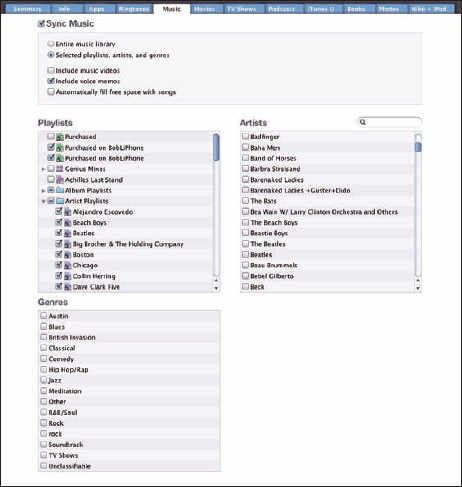
Figure 3.7. Use the Music pane to copy music, music videos, and voice memos from your computer to your iPhone.
Warning
If you choose Entire Music Library and have more songs in your iTunes library than storage space on your iPhone—more than about 7GB on an 8GB iPhone, 15GB on a 16GB iPhone, or 31GB on a 32GB iPhone—you'll see one or both of the error messages shown in Figure 3-8 when you try to sync. To avoid these errors, select playlists, artists, and genres that total less than 7, 15, or 31 gigabytes, respectively.
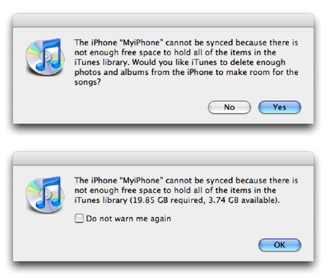
Figure 3.8. If you have more music than your iPhone has room for, this is what you'll see when you sync.
Finally, if you select the Automatically Fill Free Space with Songs check box, iTunes fills any free space on your iPhone with music.
Warning
Music, podcasts, and video are notorious for using massive amounts of storage space on your iPhone. If you try to sync too much media, you'll see lots of error messages like the ones in Figure 3-8. Forewarned is forearmed.
To transfer movies to your iPhone, select the Sync Movies check box and then choose an option for movies you want to include automatically from the pop-up menu, as shown in Figure 3-9. If you choose an option other than All, you can optionally select individual movies and playlists by checking the boxes in appropriate sections.
The procedure for syncing TV shows is slightly different from the procedure for syncing movies. First, select the Sync TV Shows check box to enable TV show syncing. Then choose how many episodes to include and whether you want all shows or only selected shows from the two pop-up menus, as shown in Figure 3-10. If you want to also include individual episodes or episodes on playlists, select the appropriate check boxes in the Shows, Episodes, and Include Episodes from Playlists sections of the TV Shows pane.
You can also sync podcasts, educational content from iTunes U, two types of books—e-books for reading and audiobooks for listening—and photos.
To transfer podcasts to your iPhone, select the Sync Podcasts check box in the Podcasts pane. Then you can automatically include however many podcasts you want by making selections from the two pop-up menus, as shown in Figure 3-11. If you have podcast episodes on playlists, you can include them by selecting the appropriate check box in the Include Episodes from Playlists section.
To sync educational content from iTunes U, first select the Sync iTunes U check box to enable iTunes U syncing. Then choose how many episodes to include and whether you want all collections or only selected collections from the two pop-up menus. If you want to also include individual items or items on playlists, select the appropriate check boxes in the Items section and Include Items from Playlists section of the iTunes U pane.
By now we're sure you know the drill: You can sync all your eBooks or audiobooks or just sync selected titles by choosing the appropriate buttons and check boxes in the Books pane.
Tip
To sync eBooks, you need the free iBooks app from the App Store. For more information on apps and the App Store, read Chapter 14.
Syncing photos is a little different from syncing other media because your iPhone has a built-in camera—two cameras, actually—and you may want to copy pictures or videos you take with the iPhone to your computer, as well as copy pictures stored on your computer to your iPhone.
The iPhone syncs photos and videos, too, with the following programs:
Mac: Aperture or iPhoto version 4.03 or later
PC: Adobe Photoshop Elements 3.0 or later
You can also sync photos with any folder on your computer that contains images.
In the Photos pane, select the Sync Photos From check box, and then choose an application or folder from the pop-up menu (which says Aperture in Figure 3-12).
If you choose an application that supports photo albums (such as Aperture and iPhoto), projects (Aperture), events (iPhoto), facial recognition (Aperture and iPhoto), or any combination thereof, you can automatically include recent projects (Aperture), events (iPhoto) or faces (Aperture and iPhoto) by making a selection from the same pop-up menu (refer to Figure 3-12).
Tip
If you're using iPhoto, you can also type a word or phrase in the search field (an oval with a magnifying glass) to search for a specific event or events. We're using Aperture in Figure 3-12, which is why you don't see the search field.
If you choose a folder full of images, you can create subfolders inside it that will appear as albums on your iPhone. But if you choose an application that doesn't support albums or events, or a single folder full of images with no subfolders, you have to transfer all or nothing.
Because we selected Aperture in the Sync Photos From menu, and Aperture 3 (the version installed on our Mac) supports projects and faces in addition to albums and photos, we have the option of syncing any combination of photos, projects, albums, and faces.
If you've taken any photos with your iPhone since the last time you synced it, the appropriate program launches (or the appropriate folder is selected), and you have the option of downloading the pictures to your computer.
